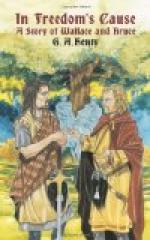Edward was about to retreat, being unable any longer to subsist his army, when the two Scottish Earls of Dunbar and Angus sent news to the king that Wallace with his army was in Falkirk forest, about six miles away, and had arranged to attack the camp on the following morning. The English at once advanced and that evening encamped at Linlithgow, and the next morning moved on against the Scots.
Late in the evening Archie’s scouts brought in the news to Wallace that the English army was within three miles, and a consultation was at once held between the leaders. Most of them were in favour of a retreat; but Comyn of Badenoch, who had lately joined Wallace, and had been from his rank appointed to the command of the cavalry, with some of his associates, urged strongly the necessity for fighting, saying that the men would be utterly dispirited at such continual retreats, and that with such immensely superior cavalry the English would follow them up and destroy them. To these arguments Wallace, Sir John Grahame, and Sir John Stewart, yielded their own opinions, and prepared to fight. They took up their position so that their front was protected by a morass, and a fence of stakes and ropes was also fixed across so as to impede the advance or retreat of the English cavalry. The Scotch army consisted almost entirely of infantry. These were about a third the number of those of the English, while Comyn’s cavalry were a thousand strong.
The infantry were formed in three great squares or circles, the front rank kneeling and the spears all pointing outwards. In the space between these squares were placed the archers, under Sir John Stewart.
The English army was drawn up in three divisions, the first commanded by the EarI Marechal, the Earl of Lincoln and Hereford; the second by Beck, the warlike Bishop of Durham, and Sir Ralph Basset; the third by the king himself. The first two divisions consisted almost entirely of knights and men-at-arms; the third, of archers and slingers.
Wallace’s plan of battle was that the Scottish squares should first receive the brunt of the onslaught of the enemy, and that while the English were endeavouring to break these the Scotch cavalry, which were drawn up some distance in the rear, should fall upon them when in a confused mass, and drive them against the fence or into the morass.
The first division of the English on arriving at the bog made a circuit to the west. The second division, seeing the obstacle which the first had encountered, moved round to the east, and both fell upon the Scottish squares. The instant they were seen rounding the ends of the morass, the traitor Comyn, with the whole of the cavalry, turned rein and fled from the field, leaving the infantry alone to support the whole brunt of the attack of the English. So impetuous was the charge of the latter that Sir John Stewart and his archers were unable to gain the shelter of the squares, and he was, with almost all his men, slain by the English men-at-arms. Thus the spearmen were left entirely to their own resources.




